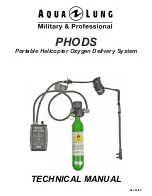
5
78-8136-3182-3
1. General Function and Description
Note: To obtain the maximum understanding and use of this instrument it is recommended that the
instruction manual be thoroughly reviewed. Follow Setup & Use procedures, observing all safety
messages and important notes listed in each of the operating functions.
The 3M
™
Charge Analyzer 711 is an electronic test instrument designed for ease of use. The lightweight and
compact construction offers great versatility in the workplace. It can be used as a laboratory analytical tool,
evaluating the performance of ionizing equipment, static-protective packaging, worksurfaces, and personnel
grounding systems. It is also very effective for use as a demonstration tool in employee static awareness training
programs.
All parameter settings are controlled via a built-in EEPROM. When the Charge Analyzer is switched off, all last
set parameters are stored in an EEPROM. These parameters are defaulted to when the analyzer is switched on
again. In case of a malfunction, the unit will display a corresponding message and then automatically switch off.
The analyzer operation works according to the fieldmill-principle. The fieldmeter is a parametric amplifier. An
electrostatic field induces a charge on the sensor electrode, generating an AC current that is proportional to the field
strength. An amplifier measures this current without reducing the energy of the electrostatic field in average time.
The analyzer is powered by built-in rechargeable NiMH-batteries or an AC wall plug-in adaptor. When the unit
is powered from the rechargeable batteries, the LCD-display will not be back illuminated to extend battery life.
This power saving feature will initiate within 60 seconds after the last measurement or button depression. Also
during battery operation, the continuous LED-bar indication changes to a single (momentary) action. In case of
a low battery power condition, the analyzer automatically switches off, first displaying
LOW BATTERY
then
SWITCHING OFF UNIT
. If this occurs, continued operation of the analyzer can be maintained through the AC
adaptor. Recharge time is approximately 14 hours with unit off, when batteries are fully discharged.
Important Note
•
Avoid extreme discharge of the rechargeable batteries. If the batteries require charging, do
not allow the unit to sit idle for a period of time without first fully charging the batteries.
Two vertical LED bars indicating 0 – 100% charge level and polarity are located on the left and right sides of
the front panel. The alphanumeric LCD-display is the information center of the analyzer and allows the user to
observe the principles of static protection. The unit’s high accuracy makes it well suited for product performance
analysis.
All interfacing connections are made at the rear of the unit. The following outputs are available: The charge
analyzer 711 can be connected to a y (t)-recorder via the +/- 2 volts analog output.
Connection to a PC for data recording purposes is available through a RS232 data port.
A Remote Field Sensor probe is connected through a 4-Pin circular socket located on the rear of the unit. The
sensor operates on the same measurement principle as described above. This feature allows to the user to make
measurements by means of a hand-held or fixed position probe in remote locations, where it may be impossible
to position the analyzer. Measurement distances with the probe are 1, 2, 5, 10, & 20 centimeters. The built-in
microprocessor automatically converts the measured field strength via the chosen distance into a charge of an
equivalent potential in volts. The display automatically switches from volts to kilovolts.
The following operating functions will be automatically activated, when the appropriate electrode or sensor is
connected to the base unit.
The charge analyzer 711 comprises of four types of independent operating functions:
• Static fieldmeter sensor – Measuring electrostatic fields
• Voltmeter - Measuring the potential on charged objects
• Static decay time – Measuring charge-decay and balance of ionizing equipment by charge plate monitor (CPM)
method.
• Remote field sensor probe – Measuring the potential on charged objects in confined areas.
Change between these operating functions will be verified on the display as
CHANGE MODE OF
OPERATION.






































